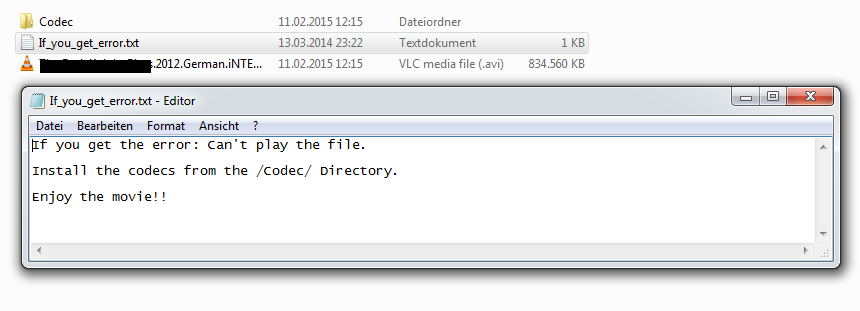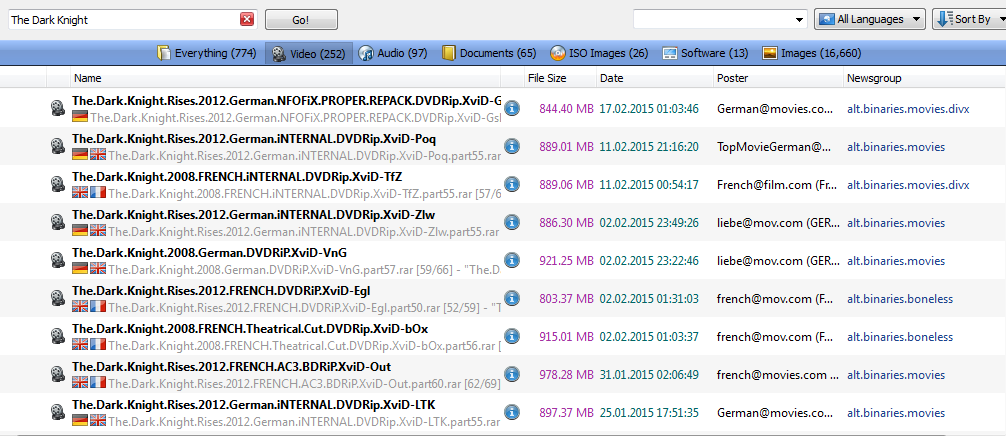Ever since Usenet became popular, spammers have become a little more common than they used to be. More experienced users have since learned to avoid the fake files posted on the network, but like with torrents, beginners sometimes find themselves a bit overwhelmed. In this guide, we’re going to show you how to detect “crap” uploads, how they look, and how to download only the great content you crave so much.
Let’s begin with an overview of the most “popular” (with the bad guys, that is…) bullshit “content” schemes.
“Make Money From Beginners”: The So-Called “Required Codec”
Imagine the following: You want to download this awesome movie you heard so much about, and you find the “perfect match”, with a 100% fitting title and even a relatively small file size. After firing up your favorite newsreader, it sits right there on your drive, and you rush to open it. But strangely enough, your media player can’t seem to play it..
Upon further inspection, you find a seemingly helpful hint in the folder:
 Oh look, what a helpful guy! Apparently, you’re only missing a little piece of software, an entirely harmless video codec, and conveniently, it is even attached to the movie. Great service, isn’t it? But after opening and installing the attached “codec”, you still can’t play the film, and strangely enough, your computer starts to bombards you with loads of ads, popups, and whatnot…
Oh look, what a helpful guy! Apparently, you’re only missing a little piece of software, an entirely harmless video codec, and conveniently, it is even attached to the movie. Great service, isn’t it? But after opening and installing the attached “codec”, you still can’t play the film, and strangely enough, your computer starts to bombards you with loads of ads, popups, and whatnot…
Almost as if there was a program on your computer, not unlike what people were used to when “adware”-supported software was all the craze.
What happened here? Well, instead of a codec (or, in some cases, “video player” or something like it), you just installed an “adware” client on your computer, made to annoy the hell out of you with aggressive advertising.
Installing the software earned the uploader something around a few cents to several dollars from the “advertising network” behind it to peddle you this piece of shit.
And that is, if you’re lucky and didn’t infect your system with a virus.
Password-Protected Archives: “Just Complete This Short Survey”
Next on the list are posts that, seemingly, require a password for you to open the content. There are some uploaded by legitimate, private groups, trying to only make their stuff accessible for members which can be bothersome but harmless. Most of the time thought, you get an archive within the archive, along with a little text file asking you to go to this or that website to “get the password”. On said website, a small survey pops up that just needs to be filled out for you to get access…
Only that, after completing it, you receive nothing at all, but the guy who set the whole thing up made a few bucks from yet another “advertising network”.
Ingenious, isn’t it, how far some people go to make a quick buck?
Mass Spamming: If They Get Just A Few Dollars From Each Of These Uploads…
True, few people fall for these tricks, but this is where mass spamming tools come into action, filling the Usenet with loads and loads of these posts. Just look what people are shown when looking for a copy of the recent blockbuster The Dark Knight (and luckily, this isn’t you, because you wouldn’t download anything protected by copyright without permission, right?).
Notice some similarities between all these fakes (and yes, they’re all not real):
- All have seemingly legit names, looking a lot like scene releases from the big groups. But notice how the release groups vary for the same movie, uploaded on almost the same date? Also, how come there is no name of the forums and websites these files often get uploaded from, and which love to advertise their URL in their posts? Strange, isn’t it?
- See how the file size is always very similar, the posters name either look like a standard one or as if generated automatically by some kind of script?
- They are ALL low definition releases, and none is larger than 1 GB. HD versions are almost never affected!
- And again, doesn’t this all look a bit suspicious at all?
All these are telltale signs something is wrong, and they will be confirmed after downloading. In contrast, here are some ways to find legitimate content.
How To Find Legitimate Content
With Search Engines:
- Especially with movies, look for high-definition versions, with a file size of more than 1.2 GB. Spammers rely on cheaply made, quick-to-upload “fast food” content, and even though bandwidth has gotten very cheap, most (but not all!) fakes have a relatively small file size.
This which can only serve to our advantage: Thanks to larger hard drives and faster connections, it doesn’t take too much time nowadays to download movies in the best quality available.And also, it is just so much more enjoyable to watch a DVD version on your big screen TV than some crummy, shrunk-down Divx-Xvid-something video! So, choose larger file sizes and you’re good to go. - Look for “scene tags” in the file title. OK, so you definitely want a small version, maybe for the movie to fit on your phone or tablet where sometimes, there is not much free space to spare. Then, you should look out for clues in the title, that might indicate who uploaded the whole thing. Most uploads are being posted by big groups for fame and glory, and so they like to brag a bit in the film titles.
Take the tags in the following screenshot for example:
See what we mean? Sometimes it is a URL, sometimes it looks differently, but there’s something very discernible in most cases. For more information on those sites and forums, check out our article on NZB sites or scroll down to the bottom. - Posters names may indicate if an uploader is legitimate or not, and although sometimes, spammers try to emulate well-known posters, these names still are at least an indication of who got this file on the network. Don’t rely too much on it, though, it is only an additional factor to consider.If you stick to the first two rules you’ll most likely be fine anyway.
With NZB Indexers And Communities (Recommended For Software And Games):
(coming soon)





Comments are closed.